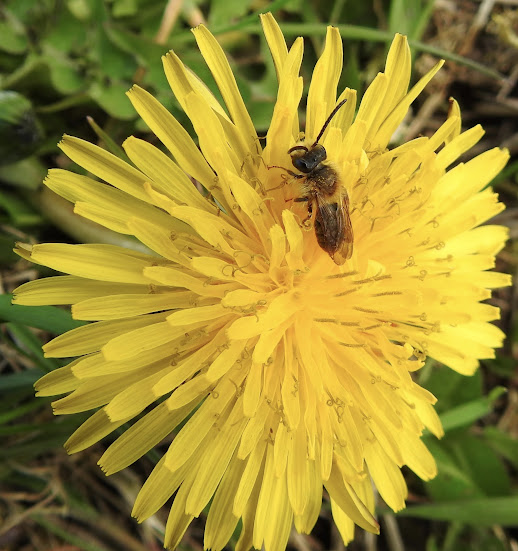Today was again on the warm side, and this time the sun shone all morning. The patch is getting popular, we saw two other birders.
It didn't take long before we started adding spring arrivals to the year list. A Sedge Warbler was singing from near the pond where the ringers often set their nets, and the first of two (or three) Grasshopper Warblers was singing from the hedges bordering the Chat field beyond. Frustratingly, none of the above was actually visible, and the same could be said of a Lesser Whitethroat which sang briefly in the distance. Common Whitethroats, Blackcaps, and Willow Warblers sang across the patch, and we actually managed to see some of those.
 |
| One of six Willow Warblers we logged today. |
Shortly afterwards a pair of Shelducks and a Little Egret flew north, a Red Kite circled, and we located the ringed Stonechat in the scrape field (so not the one I saw on Thursday).
We met up with Gary J near the flash field. Another pair of Shelducks was present on the nearest flash and also another Little Egret, but the Avocets were absent. At least one pair of Teal and a few Lapwings lurked towards the furthest flash, and four Sand Martins briefly appeared. This became more significant later in the morning as another seven flew north, pushing the record Morton Bagot count into double figures.
Scanning the tree guards has been proving profitable and today was no exception. In the distance we could see three Chats. Two were Wheatears, and the third something smaller.
 |
| Can you see them? |
Clearly we needed to check them out. Edging closer, we eventually established that the mystery Chat was a stonking male Whinchat. This was easily the earliest Whinchat I have ever seen in the UK.
 |
| Whinchat |
There was some uncertainty about the sex of the Wheatears, personally I thought they were both females, but on reflection one was probably a first-summer male.
Apart from seeing a Marsh Tit along the Morton Brook, we didn't add anything else of significance birdwise. However, butterflies were on the wing; Orange-tips, Peacocks, and Speckled Woods, and numerous bees and flies hummed and buzzed across the blossom filled hedges. It really felt as though spring was a week early.
 |
| Tawny Mining Bee (one of easy ones) |
My new interest in hoverflies was given a fillip by the discovery of a particularly striking one.
 |
| Tiger Marsh Fly Helophilus pendulus (with a Bluebottle sp) |
Nearby a nondescript solitary bee reminded me that bees are too hard.
 |
| Bee sp |
I love the spring.
No comments:
Post a Comment